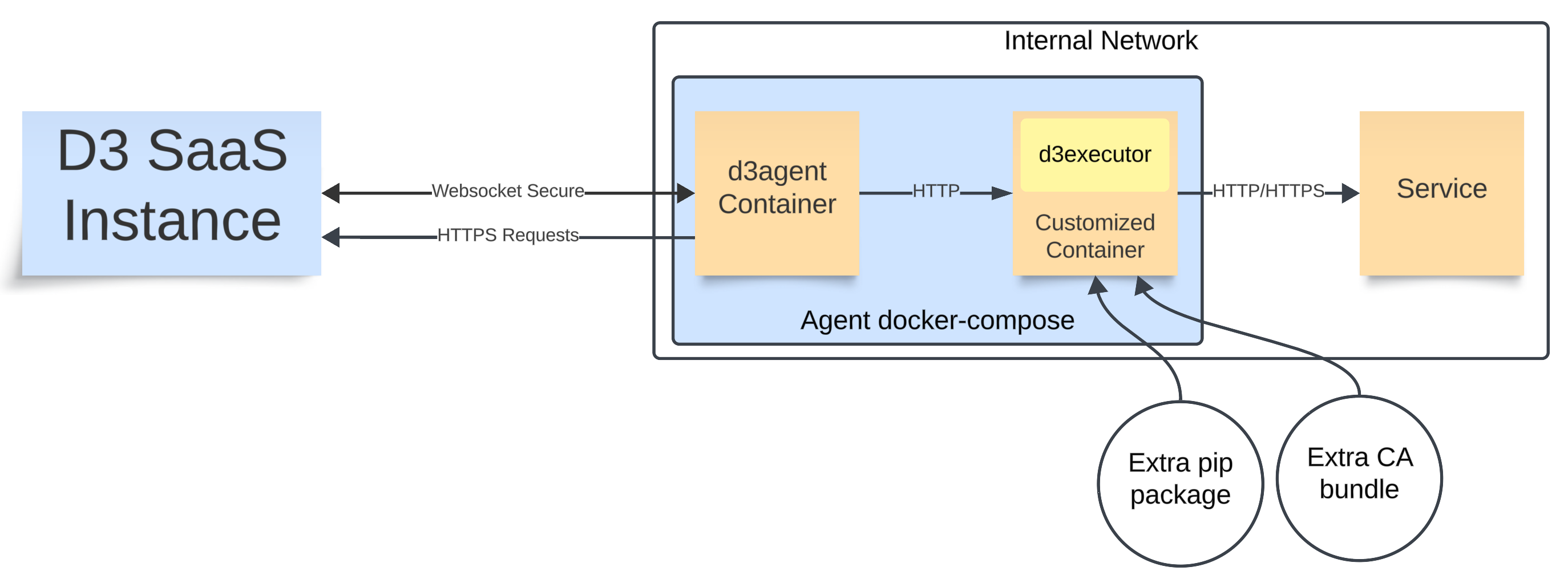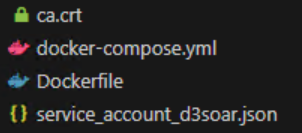Configuring Custom CA Certificate
LAST UPDATED: OCT 22, 2024
Requirement
Background
A client has an internal HTTPS service that employs a self-signed HTTPS certificate. An internal Python3 library is used to send requests to this service. The d3executor is responsible for executing Python commands that send these requests. When the d3executor sends requests to the service, it will attempt to verify the server's identity to ensure the connection is secure.

This verification process involves checking the server's HTTPS certificate against a trusted certificate authority (CA). Because the d3executor lacks access to such a CA certificate, and that HTTPS certificate verification is programmatically enabled by default, the client may encounter errors and failed requests.
Objectives
The objectives are twofold:
Enabling the client to install an internal Python package, and
Ensuring the client can successfully send requests to the service using their Python library without encountering errors.
D3 Solutions
Option 1: Rebuild d3executor Using a Customized Dockerfile

Create a Customized Dockerfile
Save the below content as a Dockerfile.
DOCKER# Use the base image FROM gcr.io/nimble-cortex-285618/d3prod/d3executor:16.8.112.0 USER root # Copy the custom CA certificate to standard directories COPY ca.crt /etc/ssl/certs/ca.crt COPY ca.crt /usr/lib/ssl/certs/ca.crt # Set environment variable for SSL cert file ENV SSL_CERT_FILE=/etc/ssl/certs/ca.crt # Update the CA certificates to include the custom CA certificate RUN update-ca-certificates # Change back to DockerUser USER DockerUser # Install Python packages from an internal repository # Replace with your own repository host, URL and any additional packages RUN pip install --trusted-host <Hostname> --index-url <Repository URL> <Packages> # Append custom CA certificate to certifi CA bundle RUN cat /etc/ssl/certs/ca.crt >> $(python -m certifi) # Entry point to run the application ENTRYPOINT ["python", "remote_server.py"]
READER NOTE
You must replace <Packages> with your own package(s). If you include two or more packages, each package must be separated by a whitespace.
--trusted-host <Hostname> --index-url <Repository URL> are optional parameters used to install packages from your own repository.
For example, the command may look something like the following:
RUN pip install --trusted-host https://pypi.org --index-url https://pypi.org/simple art arts
Rename your CA certificate as ca.crt.
Place the ca.crt file in the same folder as this Dockerfile.

Build a Docker Image
Assign the image a new name such as d3executor:16.8.112.0_customized.
Run the following docker command:
BASHdocker build -t d3executor:16.8.112.0_customized .
Edit the docker-compose File
Replace the old image name with the new image name.

Ensure that your docker-compose file is structured similarly to the sample below:
YAMLversion: "3.3" services: d3agent: image: "gcr.io/nimble-cortex-285618/d3prod/d3agent:16.8.112.0" restart: always environment: - REMOTE_SERVER_URL=http://192.168.1.190/VSOCMainAppDev169 - PROXY_IDENTITY=8012be4477724b3f915d04100d76633c - PYTHON_REMOTE_URL=http://192.168.1.212:9090 - PYTHON_REMOTE_GUID=7e036a86dbee40d9913c3794e779eae4 - SERVICE_DISPLAY_NAME=TestAgent d3executor: # image: "gcr.io/nimble-cortex-285618/d3prod/d3executor:16.8.112.0" image: "d3executor:16.8.112.0_customized" ports: - "9090:9090" restart: always # Optional: You can configure some DNS servers to allow d3executor to access your internal domains # dns: # - 192.168.1.76 # - 192.168.1.251 environment: - EXECUTOR_GUID=7e036a86dbee40d9913c3794e779eae4
Update Existing Docker Container
Run the following command to replace the existing d3executor container with the new d3executor:16.8.112.0_customized container.
BASHsudo docker compose up -dEnsure that your Docker containers are active and running.

Tested Coverage for Python Libraries
The following packages have been tested to confirm they can use the configured ca.crt directly without requiring additional settings when sending requests:
requests (relies on certifi CA bundle)
urllib3
http.client
httplib2
aiohttp
httpx
Libraries that rely on certifi CA bundle
Libraries that rely on Linux system CA certifications
Option 2: Skip the SSL Certification Verification
Use the verify=False option when writing custom Python commands with the requests library to bypass SSL certificate verification. See the example below.
PYimport requests # Define the URL for demonstration purposes url = 'https://example.com' # GET request without verifying SSL certificate response_get = requests.get(url, verify=False)
Instead of the get() method, you can also use any HTTP request methods from the requests library, such as post(), patch(), put(), and delete().
.png)